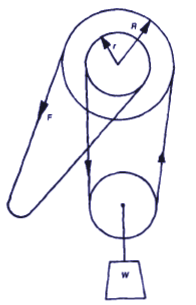Here's the answers I got:Ttonyxx wrote: ↑Tue Feb 09, 2021 11:14 am Okay, I'll guess I'll go since no one else is going.
1) Let's start easy: What are the three Archimedean simple machines?
2) A little harder: What is the ideal mechanical advantage of a 0.112in-40 UNC-3A x 0.5 screw? Explain what each of the numbers in the screw callout means.
3) In the diagram shown below, the block has a mass m = 100kg and there is a coefficient of friction μ = 0.203 between the surfaces on the top and bottom of the wedge. The angle of the wedge (between the two contact surfaces) is 15°. Assume every other surface is frictionless and the only moveable pieces are the wedge and the block. Calculate the force P required to raise the block.

1) Lever, screw, pulley
2) 0.112in refers to the major diameter. 40 means there are 40 threads per inch. UNC means the screw is a Unified National Coarse Thread screw. The 3 indicates the thread class, with 3 being the class with the lowest tolerance. "A "refers to external threads. The 0.5 means that the screw is half an inch long.
3) I got P = 687.7 N





